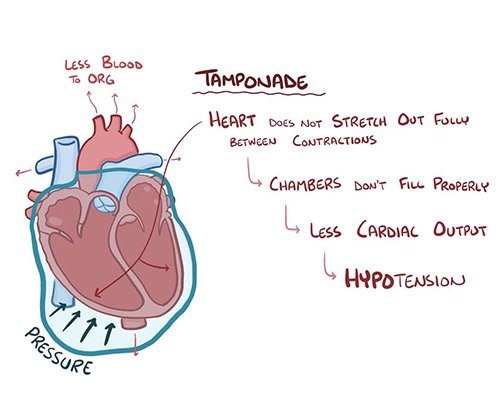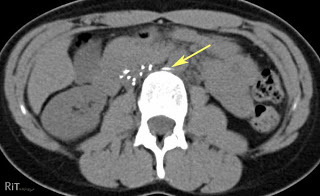A medical complication of IVC filters is cardiac tamponade, or a buildup of fluid around the heart. When IVC filters fracture and migrate, they can reach the heart and compromise the pericardium, letting blood into the space between the pericardium and the heart. This medical complication can be fatal if not treated quickly. Numerous IVC filter lawsuits have been filed by victims of cardiac tamponade or their families.
- 1. What is cardiac tamponade?
- 2. Symptoms of cardiac tamponade
- 3. Common causes of cardiac tamponade
- 4. How can an IVC filter cause cardiac tamponade?
- 5. IVC filter lawsuits stemming from cardiac tamponade

1. What is cardiac tamponade?
Cardiac tamponade is the stress on the heart that happens when blood or other fluid accumulates between the heart and the pericardium.
The pericardium is a double-walled sac that surrounds and protects the heart. The pericardium ordinarily contains some pericardial fluid inside the sac. However, if more fluid is added to the space between the pericardium sac and the heart, it can squeeze the heart because the pericardium sac cannot expand to accommodate the new fluid.
This accumulation of fluid causes stress and pressure on the heart, which is called cardiac tamponade.
Cardiac tamponade is a serious medical condition because the pressure on the heart prevents it from working properly. The heart’s ventricles cannot fully expand, keeping it from pumping enough blood to the rest of your body. The medical conditions that this can cause can be dire or even fatal, and include:
- Heart failure,
- Organ failure,
- Pulmonary edema,
- Shock, and
- Kidney failure.
2. Symptoms of cardiac tamponade
People who are suffering from cardiac tamponade can feel the following symptoms:
- Chest pain that increases with coughing or when taking a deep breath, and that can extend to the shoulder, back, neck, or abdomen,
- Physical discomfort that decreases when sitting down or leaning forward,
- Abdominal swelling,
- Breathing problems, including rapid or shallow breathing,
- General weakness,
- Lightheadedness,
- Fainting,
- Anxiety,
- Dizziness,
- Restlessness,
- Pale skin,
- Heart palpitations,
- Leg swelling,
- Low blood pressure, and
- A weak or even absent pulse.
If you experience these symptoms, you should notify your doctor.
3. Common causes of cardiac tamponade
There are numerous potential causes for cardiac tamponade, including:
- Heart attack,
- Heart surgery,
- Heart tumors,
- Cancer,
- Pericarditis, or the inflammation of the pericardium,
- Chest wounds, and
- Heart trauma.
Many cases of cardiac tamponade begin when an outside object penetrates the heart. The resulting trauma can compromise the pericardium and let blood or other fluid into the space between the pericardium and the heart.

4. How can an IVC filter cause cardiac tamponade?
IVC filters can cause cardiac tamponade when they fracture and migrate from the inferior vena cava vein and into the heart. When broken pieces of the filter reach the heart, they can penetrate or perforate the pericardium and cause cardiac tamponade by allowing fluid to enter the space between the pericardium and the heart.
4.1 How IVC filters work
IVC filters are tiny implantable medical devices that are shaped like the frame of an umbrella and made of metal. They are implanted in a patient’s inferior vena cava – the largest vein in the human body. This vein runs from the patient’s legs, through their abdomen, and to their lungs and heart.
Once positioned in the inferior vena cava, the IVC filter’s “struts” are opened just like an umbrella. The struts are designed to gain a foothold in the interior walls of the vein so they can catch blood clots traveling up the inferior vena cava.
By catching these blood clots, IVC filters are supposed to prevent pulmonary embolisms – a potentially fatal medical condition caused by blocked arteries in the lungs that are caused by blood clots. By capturing those blood clots in the inferior vena cava, IVC filters prevent them from reaching the lungs, where they could do serious damage.
4.2 Fractured and migrating IVC filters cause cardiac tamponade
IVC filters have shown a tendency to break and fracture. If this happens, they can move away from where they were implanted and migrate to the heart where they can cause cardiac tamponade.
Most IVC filters that have been implanted were only designed for temporary use. The stress of being implanted in the inferior vena cava and the filter’s steady deterioration caused by the flow of blood can fracture the filter’s thin metal struts.1
As a result, the U.S. Food and Drug Administration (FDA) has repeatedly stressed the need to remove IVC filters as soon as the risks of a pulmonary embolism have subsided.2 One medical study found that the benefits of an IVC filter begin to get outweighed by the risks between 29 and 54 days after implantation.3
However, removing an IVC filter is often delayed or never happens.4
The longer the IVC filter stays inside the body, the more likely it is to fracture. If it does break, pieces of the device can dislodge from where they were implanted and migrate. Because the flow of blood in the inferior vena cava is towards the heart, most fractured IVC filter pieces go there.
Once near the heart, IVC filters can cause a wide range of medical complications, including cardiac tamponade.
5. IVC filter lawsuits stemming from cardiac tamponade
Because these cases of cardiac tamponade were the result of the IVC filter, the injuries they have caused have led to hundreds of lawsuits against the manufacturers of the IVC filter. These lawsuits have sought compensation for the injuries caused by the IVC filter and the cardiac tamponade that it caused.
Legal References:
- See Grewal S, Chamarthy M, Kalva S, “Complications of inferior vena cava filters,” Cardiovascular Diagnosis and Therapy 6(6):632-41 (December 2016).
- U.S. Food and Drug Administration, “Removing Retrievable Inferior Vena Cava Filters: Initial Communication” (Aug. 9, 2010) and U.S. Food and Drug Administration, “Removing Retrievable Inferior Vena Cava Filters: FDA Safety Communication” (May 6, 2014).
- Morales JP, et al., “Decision analysis of retrievable inferior vena cava filters in patients without pulmonary embolism,” Journal of Vascular Surgery 1(4):376-84 (October 2013).
- Andreoli JM, Lewandowski RJ, Vogelzang RL, Ryu RK, “Comparison of complication rates associated with permanent and retrievable inferior vena cava filters: a review of the MAUDE database,” Journal of Vascular and Interventional Radiology 25(8):1181-5 (August 2014).
